

If the universe is teeming with ... - Stephen Webb - Google Livres. Ntact with alien civilizations ... - Michael A. G. Michaud - Google Livres. Paul Hughes: Exotic Civilizations: A Possible Answer To Fermi's Paradox. By Most science fiction and scientific speculation regarding our future advancement and that of advanced extraterrestrial civilizations, follows a path of increasingly visible expansion out into the galaxy.
What Are The Odds? The Milky Way Contains at Least 100 Billion Planets According to Survey (01/11/2012) - The Full Story. The full news release story: View this image Our Milky Way galaxy contains a minimum of 100 billion planets according to a detailed statistical study based on the detection of three extrasolar planets by an observational technique called microlensing.
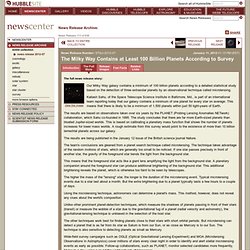
Kailash Sahu, of the Space Telescope Science Institute in Baltimore, Md., is part of an international team reporting today that our galaxy contains a minimum of one planet for every star on average. This means that there is likely to be a minimum of 1,500 planets within just 50 light-years of Earth. The results are based on observations taken over six years by the PLANET (Probing Lensing Anomalies NETwork) collaboration, which Sahu co-founded in 1995. The results are being published in the January 12 issue of the British science journal Nature. Advanced alien civilizations, have we already found some? « Astrobioloblog. Robots, Goblins and Alien Amoeba, Answering Fermi’s Paradox. By REV.
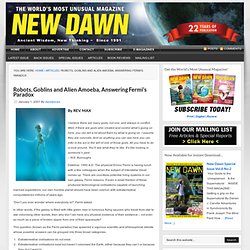
MAX I believe there are many gods, not one, and always in conflict. No Aliens in 14 Wild Ideas. Why Can't We See Evidence Of Alien Life? Universe - The Drake equation (pictures, video, facts & news) The Billion-Year Technology Gap: Could One Exist? (The Weekend Feature) The odds of there being only one single planet that evolved life among all that unfathomable vastness seems so incredible that it is all but completely irrational to believe.
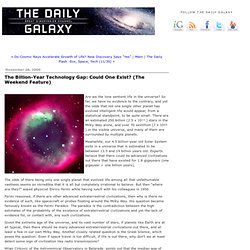
But then "where are they? " asked physicist Enrico Fermi while having lunch with his colleagues in 1950. Fermi reasoned, if there are other advanced extraterrestrial civilizations, then why is there no evidence of such, like spacecraft or probes floating around the Milky Way. His question became famously known as the Fermi Paradox. The Fermi Paradox. Fermi's Paradox Revisited by Dr. Jeff Kuhn. Fermi paradox. A graphical representation of the Arecibo message – Humanity's first attempt to use radio waves to actively communicate its existence to alien civilizations The Fermi paradox (or Fermi's paradox) is the apparent contradiction between high estimates of the probability of the existence of extraterrestrial civilization and humanity's lack of contact with, or evidence for, such civilizations.[1] The basic points of the argument, made by physicists Enrico Fermi and Michael H.
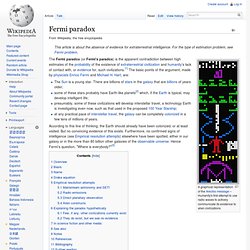
Hart, are: The Sun is a young star. Andart: Finding Fermi. Finding Fermi Inviting invasion: deep space advertisments and planetary security (Practical Ethics) - I blog about the ethics of sending adverts into space.

Calculer le nombre de civilisations extra-terrestres. La nouvelle équation qui tente de connaitre nos chances de trouver la vie ailleurs dans l’Univers. En 1961, l’astronome américain Frank Drake conçut une équation qui pourrait, théoriquement, prédire la probabilité de trouver une vie intelligente sur certaines planètes lointaines.
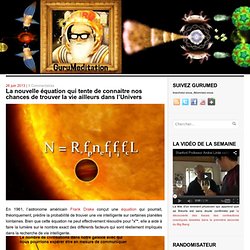
Bien que cette équation ne peut effectivement résoudre pour "x"*, elle a aidé à faire la lumière sur le nombre exact des différents facteurs qui sont réellement impliqués dans la recherche de vie intelligente. *Dans cette équation, il y a tellement d’inconnues qui ne peuvent être quantifiés que les amateurs et scientifiques y ont appliqué une variété de valeurs au cours des 50 dernières années, chacune d’elles purement spéculatives. Les valeurs de N (ces civilisations avec qui nous serions en mesure de communiquer), ont varié de une jusqu’aux millions.
Ci-dessous une représentation de son dernier travail visant a redéfinir la zone d’habitabilité, la bonne distance d’une planète par rapport à son étoile pour soutenir la vie (Towards the Minimum Inner Edge Distance of the Habitable Zone) L’équation de Seager. The Fermi Paradox - Wait But Why.
Au moins 17 milliards de planètes de taille terrestre dans la Voie lactée. Size Of The Universe. Is our universe inside a bubble? First observational test of the 'multiverse' Mib final. Journey to the Edge of the Universe. Future - Science & Environment - Drake equation: How many alien civilizations exist? Great Filter. The idea was first proposed in an online essay titled, "The Great Filter - Are We Almost Past It?

" written by economist Robin Hanson. The first version was written in August 1996 and the article was last updated on September 15, 1998. Since that time, Hanson's formulation has received recognition in several published sources discussing the Fermi paradox and its implications. Main argument[edit]
The Great Filter. Sept. 15, 1998 by Robin Hanson Humanity seems to have a bright future, i.e., a non-trivial chance of expanding to fill the universe with lasting life.
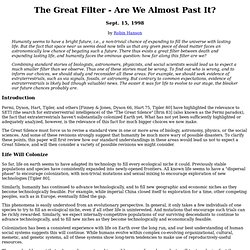
But the fact that space near us seems dead now tells us that any given piece of dead matter faces an astronomically low chance of begating such a future. There thus exists a great filter between death and expanding lasting life, and humanity faces the ominous question: how far along this filter are we? [1304.3381] Life Before Earth. Drake Equation Estimates. Moore's Law and the Origin of Life. Here’s an interesting idea.
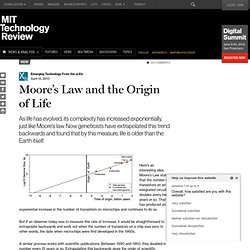
Moore’s Law states that the number of transistors on an integrated circuit doubles every two years or so. That has produced an exponential increase in the number of transistors on microchips and continues to do so. But if an observer today was to measure this rate of increase, it would be straightforward to extrapolate backwards and work out when the number of transistors on a chip was zero. In other words, the date when microchips were first developed in the 1960s. A similar process works with scientific publications. Dyson Microcosm by ~justravelin on deviantART. Dyson_Microcosm_by_justravelin.png (Image PNG, 1280x960 pixels) - Redimensionnée (79. Astronomers Find First Evidence of Other Universes. There’s something exciting afoot in the world of cosmology.
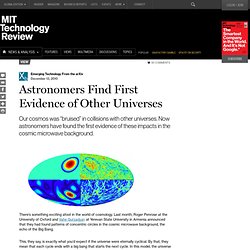
Last month, Roger Penrose at the University of Oxford and Vahe Gurzadyan at Yerevan State University in Armenia announced that they had found patterns of concentric circles in the cosmic microwave background, the echo of the Big Bang. This, they say, is exactly what you’d expect if the universe were eternally cyclical. Galerie des Futurs - A la recherche des extra-terrestres. 1787_09_03_11_11_34_53.jpeg (Image JPEG, 1200x900 pixels) Have We Found The Universe That Existed Before The Big Bang? Simulation hypothesis. The simulation hypothesis (simulation argument or simulism) proposes that reality is a simulation and those affected are generally unaware of this. The concept is reminiscent of René Descartes' Evil Genius but posits a more futuristic simulated reality.
Origins[edit] In its current form, the Simulation Argument began in 2003 with the publication of a paper by Nick Bostrom.[1] Bostrom considers that the argument goes beyond skepticism, claiming that "...we have interesting empirical reasons to believe that a certain disjunctive claim about the world is true", one of the disjunctive propositions being that we are almost certainly living in a simulation.[2] Bostrom and other writers postulate there are empirical reasons why the 'Simulation Hypothesis' might be valid.[1][3] Bostrom's trilemma is formulated in temporal logic as follows:[4] "A technologically mature "posthuman" civilization would have enormous computing power.
Descartes[edit] Descartes' Meditations Later thinkers[edit] Fractal_dyson_sphere_by_eburacum45-d2yum16.jpg (Image JPEG, 900x573 pixels) Scientists suggest we might be overlooking alien communications. A new theory has been put forward in the astrophysics world suggesting people have assumed too much when looking for alien attempts to communicate with Earth. The theory, proposed by James Benford, his son, Dominic Benford, and Jame's twin brother Gregory Benford, published in two papers in June, have generated a great deal of excitement in the science world. The Benfords looked at the issue of communications and concluded that aliens, much like humans, would want to economize their resources where possible, and thus they would not send out communications resembling what scientists have expected would be sent.
Instead, the scientists suggest, aliens might be as frugal with expensive resources as humans are. UC Irvine Feature: Beacons. Self-replicating alien probes could already be here. Fermi’s Paradox and Aristotle. Aristotle. Zoo hypothesis. Rare Earth hypothesis. The Rare Earth Hypothesis argues that planets with complex life, like Earth, are exceptionally rare An alternative view point was argued by Carl Sagan and Frank Drake, among others. Astrobiologists Find Ancient Fossils in Fireball Fragments. Planetarium hypothesis. The planetarium hypothesis, conceived in 2001 by Stephen Baxter, attempts to provide a solution to the Fermi paradox by holding that our astronomical observations represent an illusion, created by a Type III civilization capable of manipulating matter and energy on galactic scales.